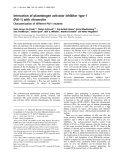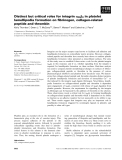
The extracellular matrix
-
Antimicrobial resistance is an emerging challenge for health personnel and researchers. In such scenario, alternative strategies targeting novel ways to kill or inhibit growth of microbes are need of the hour. Antimicrobial peptide can be a promising candidate to deal with this crisis. Extracellular matrix protein vitronectin (Vn) is recently being established as a bactericidal agent against certain microbes. Caprine Vn has got few structural alterations as compare to human Vn.
 7p
7p  nguaconbaynhay5
nguaconbaynhay5
 16-05-2020
16-05-2020
 16
16
 2
2
 Download
Download
-
In the course of trying to understand the pathogenesis of leishmaniasis in relation to extracellular matrix (ECM) elements, laminin, a major ECM protein, has been found to bind saturably and with high affinity to a 67-kDa cell surface protein of Leishmania donovani. This interaction involves a single class of binding sites, which are ionic in nature, conformation-dependent and possibly involves sulfhydryls. Binding activity was significantly enhanced by Zn2+, an effect possibly mediated through Cys-rich zinc finger-like sequences on laminin....
 8p
8p  system191
system191
 01-06-2013
01-06-2013
 41
41
 4
4
 Download
Download
-
The serpin plasminogen activator inhibitor type 1 (PAI-1) plays an important role in physiological processes such as thrombolysis and ®brinolysis, as well as pathophysiological processes such as thrombosis, tumor invasion and metas-tasis. In addition to inhibiting serine proteases, mainly tissue-type (tPA) and urokinase-type (uPA) plasminogen activators, PAI-1 interacts with dierent components of the extracellular matrix, i.e. ®brin, heparin (Hep) and vitronectin (Vn).
 9p
9p  research12
research12
 29-04-2013
29-04-2013
 25
25
 3
3
 Download
Download
-
Thea3b1 integrin is an adhesion receptor for extracellular matrix proteins including isoforms of laminin, and the changes of its expression level in various cancer cells are thought to cause their malignant phenotypes. We have cloned an approximately 4 kb DNA fragment of the 5¢-flanking region of the murinea3 integrin gene and analyzed its promoter activity.
 9p
9p  research12
research12
 23-04-2013
23-04-2013
 36
36
 3
3
 Download
Download
-
The matrix metalloproteinase (MMP) family degrades the extracellular matrix. One member of this family, MMP-1, initiates the breakdown of interstitial collagens. The expression ofMMP-1 is controlled by themitogen activated protein kinase (MAPK) pathway(s) via the activity of acti-vator protein-1 (AP-1) and polyoma enhancing activity-3/ E26 virus (PEA3/ETS) transcription factors through con-sensus binding sites present in the promoter.
 10p
10p  tumor12
tumor12
 20-04-2013
20-04-2013
 31
31
 2
2
 Download
Download
-
Earlier we presented several lines of evidence that a 67-kDa laminin binding protein (LBP) inLeishmania donovani,that is different from the putative mammalian 67-kDa laminin receptor, may play an important role in the onset of leish-maniasis, as these parasites invade macrophages in various organs after migrating through the extracellular matrix. Here we describe the membrane orientation of thisLeish-manialaminin receptor.
 8p
8p  tumor12
tumor12
 20-04-2013
20-04-2013
 45
45
 4
4
 Download
Download
-
The cell line, RCS-LTC (derived from the Swarm rat chondrosarcoma), deposits a copious extracellular matrix in which the collagen component is primarily a polymer of partially processed type II N-procollagen molecules. Transmission electron microscopy of the matrix shows no obvious fibrils, only a mass of thin unbanded filaments. We have used this cell system to show that the type II N-pro-collagen polymer nevertheless is stabilized by pyridinoline cross-links at molecular sites (mediated by N- and C-telo-peptide domains) found in collagen II fibrils processed nor-mally....
 8p
8p  tumor12
tumor12
 20-04-2013
20-04-2013
 29
29
 1
1
 Download
Download
-
Pigment epithelium-derived factor (PEDF), a neurotrophic and antiangiogenic protein, is an extracellular component of the retinal interphotoreceptor matrix which has been shown to be secreted by human fetal retinal pigment epithelial cells. It belongs to the serpin superfamily and contains the typical exposed reactive center loop. The functionof this loop is still unknown.
 10p
10p  tumor12
tumor12
 20-04-2013
20-04-2013
 30
30
 4
4
 Download
Download
-
Recently, a new protein containing a disintegrin domain, alternagin-C (Alt-C), was purified fromBothrops alternatus venom. Unlike other disintegrins, in Alt-C an ECD amino acid motif takes the place of the RGD sequence. Most dis-integrins contain an RGD/KGD sequence and are very potent inhibitors of platelet aggregation, as well as other cell interactions with the extracellular matrix, including tumor cell metastasis and angiogenesis. The present study investi-gated the effects of Alt-C on human neutrophil chemotaxis in vitro and the activation of integrin-mediated pathways....
 10p
10p  fptmusic
fptmusic
 12-04-2013
12-04-2013
 37
37
 2
2
 Download
Download
-
The urokinase-type plasminogen activator (uPA) receptor (uPAR) has been implicated in signal transduction and biological processes including cancer metastasis, angiogenesis, cell migration, and wound healing. It is a specific cell surface receptor for its ligand uPA, which catalyzes the formation of plasmin from plasminogen, thereby activating the proteolytic cascade that contributes to the breakdown of extracellular matrix, a key step in cancer metastasis.
 11p
11p  fptmusic
fptmusic
 11-04-2013
11-04-2013
 46
46
 3
3
 Download
Download
-
The dipeptidyl peptidase IV gene family contains the four peptidases dipept-idyl peptidase IV, fibroblast activation protein, dipeptidyl peptidase 8 and dipeptidyl peptidase 9. Dipeptidyl peptidase IV and fibroblast activation protein are involved in cell–extracellular matrix interactions and tissue re-modeling.
 14p
14p  inspiron33
inspiron33
 26-03-2013
26-03-2013
 41
41
 5
5
 Download
Download
-
The abundant metabolitemyo-inositol hexakisphosphate (InsP6) can form vesicular deposits with cations, a widespread phenomenon in plants also found in the cestode parasite, Echinococcus granulosus. In this organism, the deposits are exocytosed, accumulating in a host-exposed sheath of extracellular matrix termed the laminated layer.
 12p
12p  inspiron33
inspiron33
 25-03-2013
25-03-2013
 28
28
 2
2
 Download
Download
-
Integrins are the major receptor type known to facilitate cell adhesion and lamellipodia formation on extracellular matrix proteins. However, collagen-related peptide and thrombin have recently been shown to mediate platelet lamellipodia formation when presented as immobilized surfaces.
 12p
12p  inspiron33
inspiron33
 23-03-2013
23-03-2013
 56
56
 2
2
 Download
Download
-
The dystroglycan adhesion complex consists of two noncovalently interact-ing proteins: a-dystroglycan, a peripheral extracellular subunit that is extensively glycosylated, and the transmembrane b-dystroglycan, whose cytosolic tail interacts with dystrophin, thus linking the F-actin cytoskele-ton to the extracellular matrix.
 15p
15p  inspiron33
inspiron33
 23-03-2013
23-03-2013
 35
35
 4
4
 Download
Download
-
Chitinase-like proteins have been identified in insects and mammals as non-enzymatic members of the glycoside hydrolase family 18. Recently, the first molluscan chitinase-like protein, namedCrassostrea gigas(Cg)-Clp1, was shown to control the proliferation and synthesis of extracellular matrix components of mammalian chondrocytes.
 9p
9p  galaxyss3
galaxyss3
 19-03-2013
19-03-2013
 44
44
 4
4
 Download
Download
-
Snake venom metalloproteinases (SVMPs) have recently been shown to interact with proteins containing von Willebrand factor A (VWA) domains, including the extracellular matrix proteins collagen XII, collagen XIV, mat-rilins 1, 3 and 4, and von Willebrand factor (VWF) via their cysteine-rich domain.
 11p
11p  galaxyss3
galaxyss3
 19-03-2013
19-03-2013
 42
42
 4
4
 Download
Download
-
Among molluscs, the shell biomineralization process is controlled by a set of extracellular macromolecular components secreted by the calcifying mantle. In spite of several studies, these components are mainly known in bivalves from only few members of pteriomorph groups.
 13p
13p  galaxyss3
galaxyss3
 19-03-2013
19-03-2013
 41
41
 3
3
 Download
Download
-
Basement membranes are sheets of extracellular matrix that separate epi-thelia from connective tissues and outline muscle fibers and the endothelial lining of blood vessels. A major function of basement membranes is to establish and maintain stable tissue borders, exemplified by frequent vascu-lar breaks and a disrupted pial and retinal surface in mice with mutations or deletions of basement membrane proteins.
 12p
12p  galaxyss3
galaxyss3
 19-03-2013
19-03-2013
 34
34
 2
2
 Download
Download
-
Oxidative functions of polymorphonuclear neutrophils (PMNs), which play a deciding role in the phagocytosis process, are stimulated by extracellular matrix proteins such as type I collagen. Previous studies have demonstrated the involvement of a DGGRYY sequence located within the a1 chain C-terminal telopeptide in type I collagen-induced PMN activation, but so far the mechanism has not been completely elucidated.
 10p
10p  galaxyss3
galaxyss3
 07-03-2013
07-03-2013
 56
56
 6
6
 Download
Download
-
Matrix metalloproteinase-9 (MMP-9) displays a preference for a broad range of substrates including extracellular matrix proteins and cytokines. MMP-9 plays an important role in physiological processes, as well as in inflammatory diseases and numerous cancers.
 13p
13p  media19
media19
 05-03-2013
05-03-2013
 34
34
 1
1
 Download
Download
CHỦ ĐỀ BẠN MUỐN TÌM
































